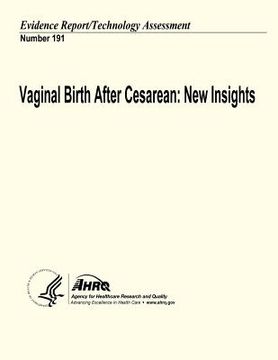Vaginal Birth After Cesarean: New Insights: Evidence Report/Technology Assessment Number 191 (en Inglés)
Reseña del libro "Vaginal Birth After Cesarean: New Insights: Evidence Report/Technology Assessment Number 191 (en Inglés)"
Despite the Healthy People 2010 national goal to reduce the cesarean delivery rate to 15 percent of births each year, this century has set record rates of cesarean deliveries. When the national rate of cesarean delivery was first measured in 1965, it was 4.5 percent, in 2007, almost one in three women in the United States (U.S.) delivered by cesarean (32.8 percent cesarean delivery rate in 2007). With almost 1.5 million cesarean surgeries performed every year, cesarean is the most common surgical procedure in the U.S. Vaginal birth after cesarean (VBAC) emerged from the 1980 National Institutes of Health (NIH) Consensus Conference on Cesarean as a mechanism to safely reduce the cesarean delivery rate. VBAC proved to be an effective contributor to reduce the use of cesarean through the early 1990s. From 1990 through 1996, the VBAC rate rose from 19.9 to 28.3 percent and the cesarean rate declined from 22.7 to 20.7 percent. Since 1996, VBAC rates have declined sharply, to the point where over 90 percent of women with a prior cesarean will deliver by repeat cesarean. While primary cesarean accounts for the largest number of cesarean deliveries, the largest single indication for cesarean is prior cesarean accounting for 534,180 cesareans each year, thus the safety of VBAC remains important. The degree to which cesarean deliveries and VBACs are improving or adversely affecting health remains a subject of continued controversy and uncertainty. This systematic review was conducted to inform the 2010 NIH Consensus Development Conference to evaluate emerging issues relating to VBAC. An evidence report focuses attention on the strengths and limits of evidence from published studies about the effectiveness and/or harms of a clinical intervention. The development of an evidence report begins with a careful formulation of the problem. The Evidence-based Practice Center (EPC) systematically reviewed the relevant scientific literature on key questions relating to VBAC assigned by the Agency for Healthcare Research and Quality (AHRQ), the Planning Committee for the NIH Consensus Development Conference on VBAC: New Insights, the National Institutes of Health's Office of Medical Applications of Research (OMAR), and further refined by a technical expert panel (TEP). Ultimately, two background questions and four key questions were reviewed for this report: What are the rates and patterns of utilization of trial of labor after prior cesarean, vaginal birth after cesarean, and repeat cesarean deliveries in the United States? What are the nonmedical factors (provider type, hospital type, etc.) that influence the patterns and utilization of trial of labor after prior cesarean? Background questions will be addressed in the introduction of the report with information from reputable sources; however, these data are not part of the systematic review process. Key Questions include: 1. Among women who attempt a trial of labor after prior cesarean, what is the vaginal delivery rate and the factors that influence it? 2. What are the short- and long-term benefits and harms to the mother of attempting trial of labor after prior cesarean versus elective repeat cesarean delivery, and what factors influence benefits and harms? 3.What are the short- and long-term benefits and harms to the baby of maternal attempt at trial of labor after prior cesarean versus elective repeat cesarean delivery, and what factors influence benefits and harms? 4. What are the critical gaps in the evidence for decision-making, and what are the priority investigations needed to address these gaps?

